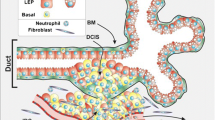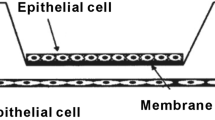Abstract
Our previous studies showed that relaxin promotes differentiation of MCF-7 breast adenocarcinoma cells. In the current investigation, we aimed to elucidate whether the effect of the hormone is potentiated when MCF-7 cells are grown together with myoepithelial cells, thus creating a microenvironment reminiscent of the organised tissue architecture of the mammary parenchyma in vivo. The findings obtained reveal that most MCF-7 cells cultured alone have an undifferentiated, blast-like phenotype, only a minority showing a more differentiated phenotype with more organelles and rudimentary intercellular junctions. When co-cultured with myoepithelial cells more MCF-7 cells acquire ultrastructural features consistent with a more differentiated phenotype, such as a rich organellular complement, apical microvilli and intercellular junctions. When relaxin was added to the co-cultures, the ultrastructural signs of differentiation could be observed in even more MCF-7 cells and became more pronounced than in the absence of the hormone, judged by the appearance of a clear-cut polarisation of cytoplasmic organelles, an almost continuous coat of apical microvilli and numerous intracellular pseudolumina.
Similar content being viewed by others

Author information
Authors and Affiliations
Rights and permissions
About this article
Cite this article
Bani, D., Riva, A., Bigazzi, M. et al. Differentiation of breast cancer cells in vitro is promoted by the concurrent influence of myoepithelial cells and relaxin. Br J Cancer 70, 900–904 (1994). https://doi.org/10.1038/bjc.1994.417
Issue Date:
DOI: https://doi.org/10.1038/bjc.1994.417
- Springer Nature Limited
This article is cited by
-
Dynamic and influential interaction of cancer cells with normal epithelial cells in 3D culture
Cancer Cell International (2014)
-
Myoepithelial cells: good fences make good neighbors
Breast Cancer Research (2005)
-
Putting tumours in context
Nature Reviews Cancer (2001)
-
Cytokines facilitate chemotactic motility of breast carcinoma cells
Breast Cancer (2000)



